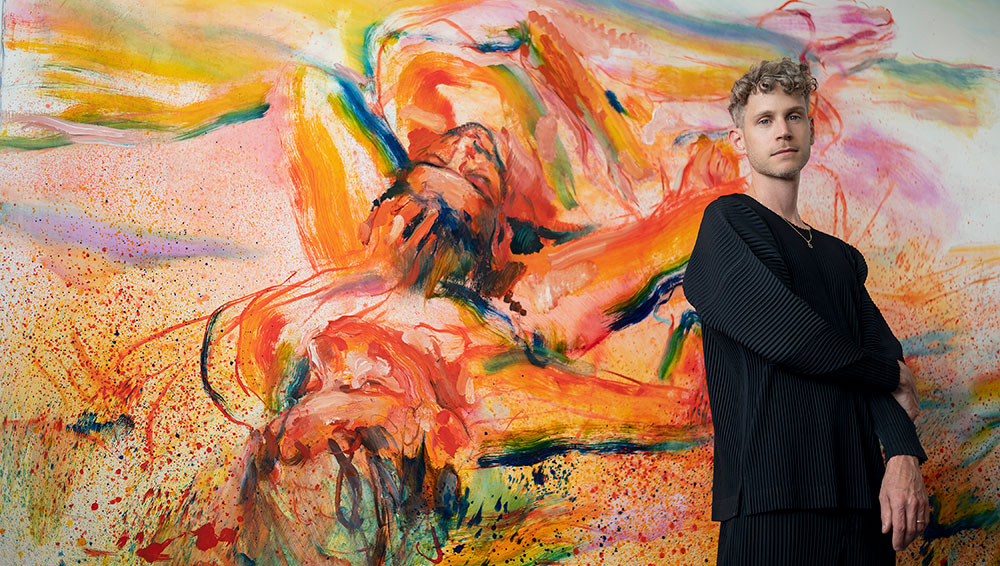
Portrait of Doron Langberg, 2021. © Nir Arieli.
by JOE LLOYD
Doron Langberg (b1985, Israel) created his first oil painting when he was six years old. It was a picture of Ariel, Disney’s little mermaid, sitting on a rock in the manner of Edvard Eriksen’s similarly iconic 1913 sculpture of the same name in Copenhagen. Langberg was disarmingly competent for a child of his age, and the picture is now the first post on his Instagram feed. His practice has developed immeasurably in the decades since. But this early work does contain some of the seeds that have informed his practice: expressive, chromatic colours, an openness to bodies and an unabashed queerness.
Langberg, who is based in Brooklyn, made his name with a succession of explicit portraits of sex. Some capture various moments of intimacy, whether on the bed or by the sea. Others get up close and personal, capturing sex acts with a blazing exuberance. There is an emotional charge to these works redolent of the great expressionists of the early 20th century. There is a tenderness, and a tactility. “I really wanted to foreground the physicality of the painting,” says Langberg.

Doron Langberg, Bather, 2021. Oil on linen, 243.8 x 203.2 cm. © Doron Langberg. Courtesy the artist and Victoria Miro.
Give Me Love, the artist’s first solo exhibition at Victoria Miro Gallery, shows him extending his purview, while depicting people and places close to his heart. One work, Bather (2021), shows his partner taking a bath in their New York apartment, in a homage to Pierre Bonnard’s baignoires of his wife Marthe. Another, Brothers (2021), shows Langberg and his two brothers in a luminous landscape, the artist crouching amid blood-red flowers. The scene stems from a hike they took in the Menashe mountains of his native Israel in early 2020, following the loss of their sister; she is captured in the tender portrait Sister (2021). And in Yokneam (2021), Langberg presents a landscape without figures, dominated instead by the mournful forms of cypress trees.
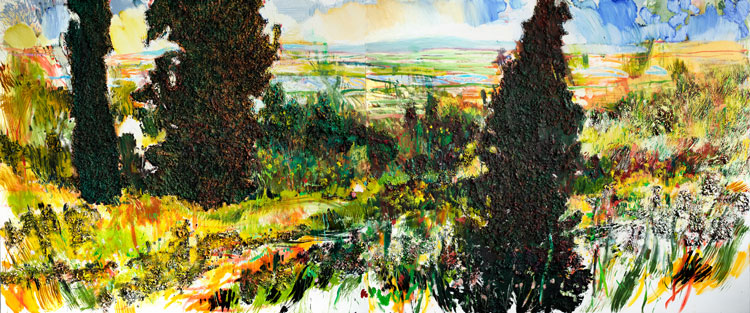
Doron Langberg, Yokneam, 2021. Oil on linen, 203.2 x 487.7 cm (80 x 192 in). © Doron Langberg. Courtesy the artist and Victoria Miro.
Studio International caught up with the talkative, thoughtful Langberg ahead of the show’s opening.
Joe Lloyd: When did you decide to become an artist?
Doron Langberg: I’ve always been a painter! I started painting in oil when I was six years old. But it wasn’t a conscious decision, it was something that I’ve always loved. And my parents were super-encouraging. The reason I started painting in oil was because my dad, who is a maths professor, went away to some convention in the US, when I was really young. And he went into this arts store and said, “My son is a painter, what can I get him?” and they said – I guess he didn’t tell them I was so young – “Oh, take this oil-painting kit.” And he brought it back, and that’s how I started.
JL: What was your earliest work?
DL: Actually, my first painting was of The Little Mermaid, which I feel is a sort of proto-gay painting. I painted it when I was six. It’s that iconic scene when she’s on the rock. But for some reason she’s holding a compact mirror or another bra, I don’t know what she’s holding. So that’s the genesis of my painting.
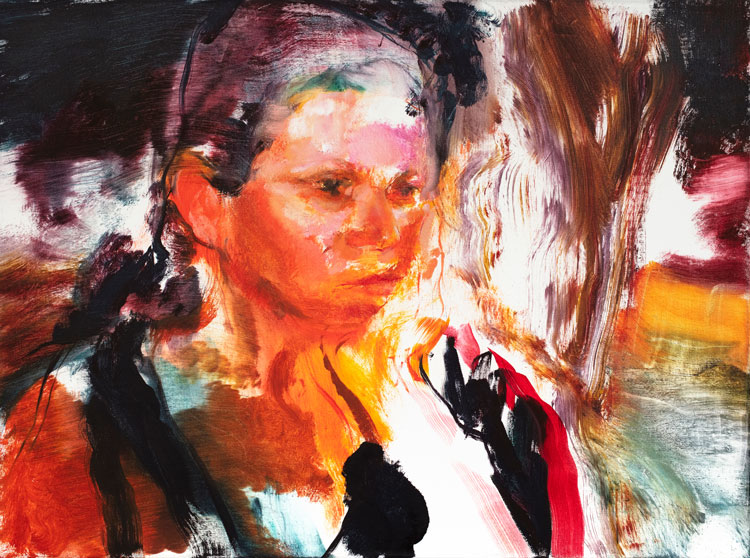
Doron Langberg, Sister, 2021. Oil on linen, 45.7 x 61 cm (18 x 24 in). © Doron Langberg. Courtesy the artist and Victoria Miro.
JL: Let’s talk a little about your training. When did you move to the US?
DL: I was in Israel until I was 21, and then I moved to the US to study at the Pennsylvania Academy of Fine Arts. It was the first art school in the US, and it’s kind of a traditional programme. For the first year, you study painting, sculpture and printmaking, and then you choose a concentration, which for me was painting. I worked on tons of paintings from observation, life-modelling and stuff like that. Working from observation has always been a really big part of what I love to do. The second half of undergrad was just studio work, so they basically give you a space and you can do whatever you want. It’s kind of amazing because I feel most undergrad programmes only have a year of that, so that was a great experience.
That was the first time I started working with queer subject matter. I made this video for a friend, of us hooking up when I was visiting Israel. When I came back to the studio, I was looking at it and I thought, “I love the composition, the light is really good” and I just started drawing from that. The drawings were very expressive: they were these tiny graphite drawings, scribbling and smearing and stuff like that. I feel like the material and the sexual subject matter from the beginning of this process were meshed together for me: thinking about sensual subject matter through the sensuality of the material.
I feel like I was just following my impulses and not necessarily thinking too much about it. I liked that process where I just tried to be really attentive to what it is that I’m drawn to, and then try to understand how it operates in the world, what does it mean to me. I had professors come into the studio and ask: “Why are you drawing this?” And I was like: “Well, this just feels really true to my experience.” A basic part of human life that everyone can relate to, but it’s also maybe particular to queer experience.

Doron Langberg, In My Lap, 2021. Oil on linen, 243.8 x 203.2 cm. © Doron Langberg. Courtesy the artist and Victoria Miro.
JL: It’s interesting to me that they questioned that, given sensuality is such a significant strand in the history of art.
DL: During training, I was really attracted to things that are so cemented in the history of painting: sexuality, portraiture, these themes that have such a history. It was more just trying to find my own voice within something that’s already so established. And that’s why I started with drawing instead of painting. I almost felt there was no room for me within the painting discipline or painting with oil. It was so fraught and so heavy. Drawing really helped shed a lot of the weight.
JL: How do you choose your subjects?
DL: All the people, especially in this show, are very, very close, a sort of extreme inner circle: my two brothers and myself, my sister, the place where I grew up, my partner.
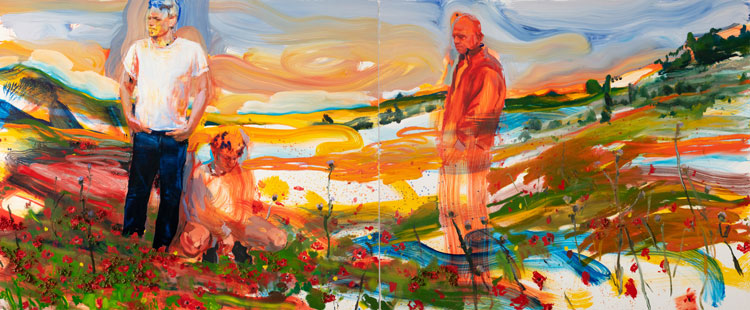
Doron Langberg, Brothers, 2021. Oil on linen, 203.2 x 487.7 cm (80 x 192 in). © Doron Langberg. Courtesy the artist and Victoria Miro.
JL: How do your paintings begin?
DL: The idea comes with a certain formal component. So, it’s both a subject and a colour idea, a material idea or a composition. There’s something for me to start off with formally. With Brothers (2021), for example, I knew that I wanted extremely gestural, turbulent brushstrokes. It is based on a hike that my brothers and I took when we were in Israel together right before the pandemic, because my sister passed away and we were there for the shiva. It was February, so in Israel, at least, the beginning of spring. There were all these wildflowers, and I was there, and I thought: “This has to be a painting.”
So, certain moments either present themselves in real time or later, like this would have been: “Oh, let me recreate this.” It’s something that comes up very organically. I think my job essentially is to try to be really attentive to these impulses and latch on to them. And that’s how these come about.

Doron Langberg, Ragwort, 2021. Oil on linen, 243.8 x 203.2 cm. © Doron Langberg. Courtesy the artist and Victoria Miro.
JL: There’s also a lot of art historical reference in your work.
DL: I think a lot of the art historical references are there to place the painting emotionally, you know what I mean? Bather (2021), for example, is almost like a one-to-one Bonnard composition, with the small towels in the bottom, and this pile of clothes in lieu of the dog that was there. For me, by quoting or doing a direct homage, you can bring the emotional charge that Bonnard has in his paintings. Or with, thinking about the cypresses [in Yokneam (2021)] as being close to Van Gogh. Because they are traditionally planted on the edge of cemeteries, and so bring this subtle notion of mortality into this landscape through the art historical reference, if that makes sense.
JL: The show contains almost the full gamut of genres. How does it fit together?
DL: That was kind of a conflict I had, working with so many different subjects. I was really thinking about how the materiality and the colour and the touch of them connects the pieces together. You can see really intense brush strokes here that are describing hands and a dick or an arsehole or whatever, that transitions into these sweeping brushstrokes, and then this horizon line. In my mind, they are connected by the touch of the work and the sensibility of the paint.
That’s kind of why I see it representing my subjectivity, do you know what I mean? Yes, there’s elements in the work that are demonstrably queer, where you can identify the queerness by the subject matter. But I think it’s important to also express other aspects of my life that don’t necessarily read as queer but are part of me as a human being.
I feel like I don’t want to reduce queer experience to the sexuality of it, which is not just how I experience my life. It’s a very straight point of view to do that. I think that queerness ties into my relationship with my family, and I think it ties into my relationship with the state. There are so many different aspects. So, I wanted to just have more room for those types of experiences within the show.
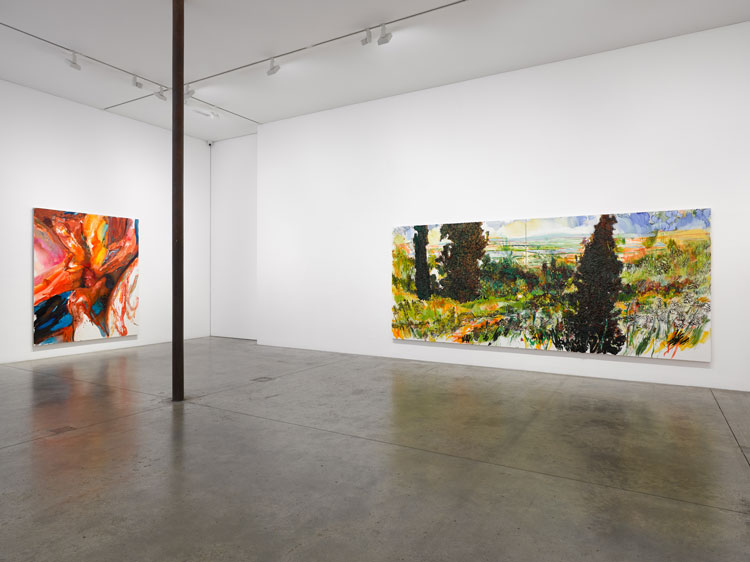
Doron Langberg: Give Me Love, Installation view, Victoria Miro Gallery I, London, 3 September – 6 November 2021. © Doron Langberg. Courtesy the artist and Victoria Miro.
JL: Can a landscape such as Yokneam (2021) express such queer subjectivity?
DL: I was talking to a friend of mine who is a writer, and he brought up the idea of cruising and nature, people who need a certain kind of escape or hiding place. That was not at all what I brought into the piece, but it was interesting to hear that he projected this queer subject matter, queer content on to it. This is my first time painting a landscape and so I’m honestly still thinking about those questions. I think that it represents a certain edge of my practice, in terms of distance from an explicitly queer experience.
JL: Who, would you say, are your paintings for?
DL: I think that my imagined audience is the people in my immediate vicinity whom I talk to and who see my work, because they’re the people that I experience seeing a work. Obviously, that’s something that’s changing as the work gets more and more exposure. And I think that, in a way, the more people see the work, and the more I’m aware of their response, I think that gets into the process itself in terms of trying to have clarity about what it is I want to say, and how I want to say it. But, in my head, it’s for myself and other painters and people who are close to me who I get to interact with.
JL: So, it’s important to talk with other artists?
DL: Absolutely! Oh my God, yeah, especially in New York where there are so many painters I'm close to. Some of them work with very similar subject matter, such as Salman Toor, Louis Fratino, and Jenna Gribbon, and some of them work in totally different modes, like my good friend Gaby Collins-Fernandez, and Julia Bland. I think that it’s just so natural for me to respond to their work, and for them to respond to my work. We’re just in this very close community.
JL: The show is named after a pop song. Can painting have the same immediacy?
DL: I think so! In the same way that a pop song can overtake you, I want that from painting, and I think a lot of painting does that. When you see, say, a Van Gogh, there’s just this rush of empathy and emotion. To me, at least, it’s part of experiencing a painting. As an object, painting really connects you to another person in a really direct way. I think that immediacy and closeness is unique to viewing paintings.
• Doron Langberg: Give Me Love is at Victoria Miro, London, until 6 November 2021.